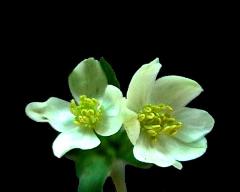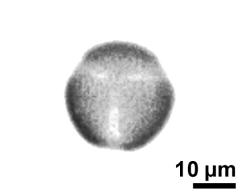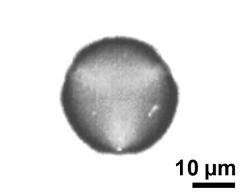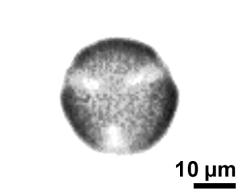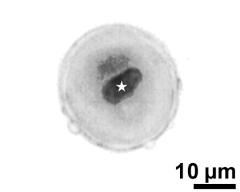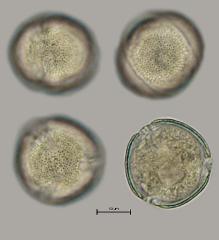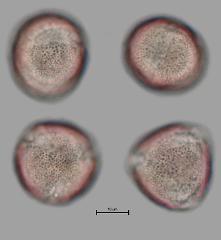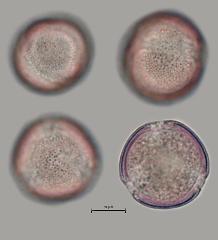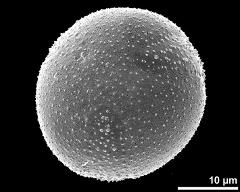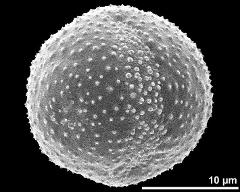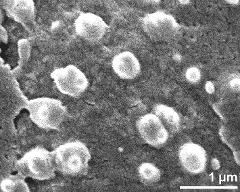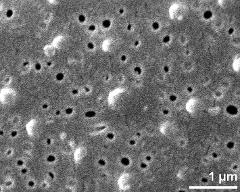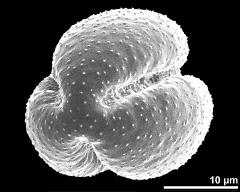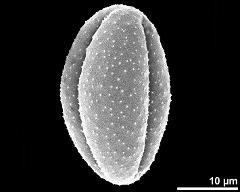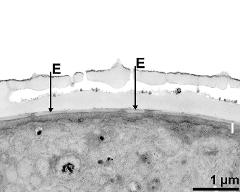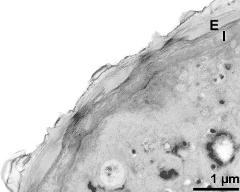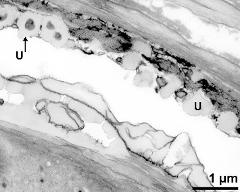Anemone narcissiflora
Taxonomy: Angiospermae, Ranunculales, Ranunculaceae, Anemone
Links: http://flora.nhm-wien.ac.at/Seiten-Arten/anemone-narcissiflora.htm
Published: 2021-03-08
Pollen Description
Shape, Size and Aperture
pollen unit: monad, dispersal unit and peculiarities: monad, size (pollen unit): small (10-25 µm), size of hydrated pollen (LM): 26-30 µm, 21-25 µm, shortest polar axis in equatorial view (LM): 21-25 µm, longest polar axis in equatorial view (LM): 26-30 µm, shortest diameter in equatorial or polar view (LM): 26-30 µm, longest diameter in equatorial or polar view (LM): 21-25 µm, pollen class: colpate, polarity: isopolar, P/E-ratio: -, shape: spheroidal, outline in polar view: circular, dominant orientation (LM): oblique, P/E-ratio (dry pollen): prolate, shape (dry pollen): -, outline in polar view (dry pollen): lobate, infoldings (dry pollen): aperture(s) sunken, aperture number: 3, aperture type: colpus, aperture condition: tricolpate, colpate, aperture peculiarities: aperture membrane ornamented
Ornamentation and Structure
LM ornamentation LM: verrucate, gemmate, scabrate, nexine: -, sexine: -, SEM ornamentation SEM: perforate, microechinate, suprasculpture SEM: -, TEM tectum: eutectate, infratectum: columellate, foot layer: continuous, endexine: compact-continuous, intine: monolayered, wall peculiarities: -, supratectal element: -
Miscellaneous
pollen coatings: pollenkitt, reserves in cytoplasm: lipids, starch, cell number: 2-celled, Ubisch bodies: present
Annotations: endexine sporadically interrupted
Author(s) of diagnosis: Auer, Angelika; Auer, Waltraud
Pictures
Picture legend
- flower(s), photographer: Auer, A.
- polar view (proximal) - fresh, acetolyzed, unstained, photographer: Auer, A.
- optical section - fresh, acetolyzed, unstained, photographer: Auer, A.
- polar view (distal) - fresh, acetolyzed, unstained, photographer: Auer, A.
- pollen grain with generative cell (asterisk) and vegetative nucleus - fixed, formalin-acetic-alcohol, aceto-carmine, photographer: Auer, A.
- hydrated pollen - fresh, glycerine, unstained, photographer: Auer, W.
- hydrated pollen - fresh, glycerine, ruthenium red, photographer: Auer, W.
- hydrated pollen - fresh, glycerine, ruthenium red, photographer: Auer, W.
- polar view - fresh, rehydrated (water) & critical point dried & sputter coated with gold, photographer: Auer, A.
- equatorial view - fresh, rehydrated (water) & critical point dried & sputter coated with gold, photographer: Auer, A.
- detail of colpus membrane - fresh, rehydrated (water) & critical point dried & sputter coated with gold, photographer: Auer, A.
- exine surface - fresh, rehydrated (water) & critical point dried & sputter coated with gold, photographer: Auer, A.
- polar view (dry pollen grain) - dry, sputter coated with gold, photographer: Auer, A.
- dry pollen grain in equatorial view - dry, sputter coated with gold, photographer: Auer, A.
- interapertural area of pollen wall, intine (I), endexine (E) - fresh, glutaraldehyde & osmium & potassium ferrocyanide, uranyl acetate & lead citrate, photographer: Auer, A.
- apertural area of pollen wall, intine (I), endexine (E) - fresh, glutaraldehyde & osmium & potassium ferrocyanide, uranyl acetate & lead citrate, photographer: Auer, A.
- pollen wall (bottom) and tapetum cells with Ubisch bodies (U) - fresh, glutaraldehyde & osmium & potassium ferrocyanide, uranyl acetate & lead citrate, photographer: Auer, A.
Literature
- (1991) The Northwest European Pollen Flora, 51. Ranunculaceae. Rev Palaeobot Palynol 69: 117-271
- (1986) Contribución al conocimiento palinológico de la familia Ranunculaceae en Andalucía. I. Subfam. Helleboroideae. Lagascalia 14: 13-23
- (1987) Aquifoliaceae, Aristolochiaceae, Berberidaceae, Caesalpiniaceae, Cucurbitaceae, Cyperaceae, Fabaceae, Frankeniaceae, Malvaceae, Nymphaeaceae, Paeoniaceae, Plumbaginaceae, Poaceae, Primulaceae, Rafflesiaceae, Ranunculaceae, Rhamnaceae, Santalaceae, Tamaric In: Valdés B., Diez M.J., Fernández I. (eds) Atlas polinico de Andalucia occidental. Inst de Desarrollo Regional 43, Univ de Sevilla
- (1985) Studies on palynology of some Ranunculaceae from the Garhwal Himalayas. In: Varghese T.M. (ed) Recent Advances in Pollen Research. Allied Publishers : 315-321
- (1970) Pollen and the origin of the Australian Anemones (Ranunculaceae). Bot J Linn Soc 63: 91-93
- (1974) Emploi des données de la morphologie du pollen actuel à l'appui de la théorie de la dérive des continents. Réflexion méthodologiques. Les genres Impatiens et Anemone. Sci Géol Bull, Strasbourg 27: 185-193
- (1970) Le pollen du genre Anemone et du genre Hepatica (Ranunculaceae) et leur taxonomie. Pollen et Spores 12: 329-364
- (1991) Palynotaxonomy and phylogeny of Ranunculaceae. Geophytology 21: 207-210
- (1978) On the palynomorphological types of the Armenian Rununculaceae. Biol Zh Armenii 31: 219-222, 5 pl
- (1983) A palynological study of the genus Helleborus (Ranunculaceae). Grana 22: 129-140
- (1998) Pollenmorphologie der Ranunculanae. Diplomarbeit. Universität Wien : 125 pp
- (1981) Palynomorphological characteristics of the Bulgarian representatives of the family Ranunculaceae VII & VIII. Phytology (Bulg Acad Sci) 17: 3-32
- (1980) Palynomorphological characteristics of the Bulgarian representatives of the family Ranunculaceae Juss. V. Phytology (Bulg Acad Sci) 15: 22-61
- (1937) Cercetari citologice, anatomo - fiziologice si taxonomice la Anemonele din sectio Hepatica. Bul Grad Bot Si Muz Bot Univ Cluj 17
- (1979) A palynological study of the tribe Ranunculeae. Opera Bot 48: 74 pp
- (1986) Cytological studies of Anemone nemorosa L. (Ranunculaceae). Bot J Linn Soc 92: 255-262
- (1964) Pollen morphology of the genus Anemone L. Acta Bot Sinica 12: 19-39
- (1987) Palynological study of the genus Anemone (Ranunculaceae) from Nepal in connection with their systematics. Bot Journ USSR 72: 887-897
- (1963) Studies of Indian pollen grains - II. Ranunculaceae. Pollen et Spores 5: 285-296
- (1936) Pollen grains in the identification and classification of plants - VII. Ranunculaceae. Bull Torrey Bot Club 63: 495-514
- (1964) Pollen morphology of the genus Anemone L. Acta Bot Sinica 12: 21-32, 6 pl
- (1994) Exkursionsflora von Österreich : 1180
- (1998) Preparing living pollen material for scanning electron microscopy using 2,2-dimethoxypropane (DMP) and criticalpoint drying. Biotechnic Histochem 73: 137–143
Copyright and Citation
Cite this publication as:
Auer A., Auer W. 2021. Anemone narcissiflora. In: PalDat - A palynological database. https://www.paldat.org/pub/Anemone_narcissiflora/305597; accessed 2025-10-31

